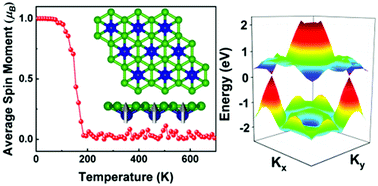Ferromagnetic Dirac half-metallicity in transition metal embedded honeycomb borophene†
Abstract
Exploring two-dimensional (2D) ferromagnetic materials with intrinsic Dirac half-metallicity is crucial for the development of next-generation spintronic devices. Based on first-principles calculations, here we propose a simple valence electron-counting rule to design such materials and endow them with good stability and desirable magnetic properties. Taking honeycomb borophene as a prototype, we demonstrate that embedding open-shell transition metal (like Cr) atoms in the hexagonal ring of boron atoms can provide two valence electrons to fully occupy the in-plane σ and out-of-plane π bands of B atoms. The remaining four valence electrons reside in d orbitals that split under C6v symmetry, yielding a magnetic moment of ∼2 μB per Cr atom. The resulting CrB2 monolayer exhibits a Dirac half-metal band structure, a high Curie temperature of 175 K, and a large out-of-plane magnetic anisotropy energy of 4 meV per Cr simultaneously. Our work establishes a feasible route for the experimental realization of ferromagnetic Dirac half-metallicity in 2D materials and provides new opportunity to realize high-speed devices with low consumption.



 Please wait while we load your content...
Please wait while we load your content...